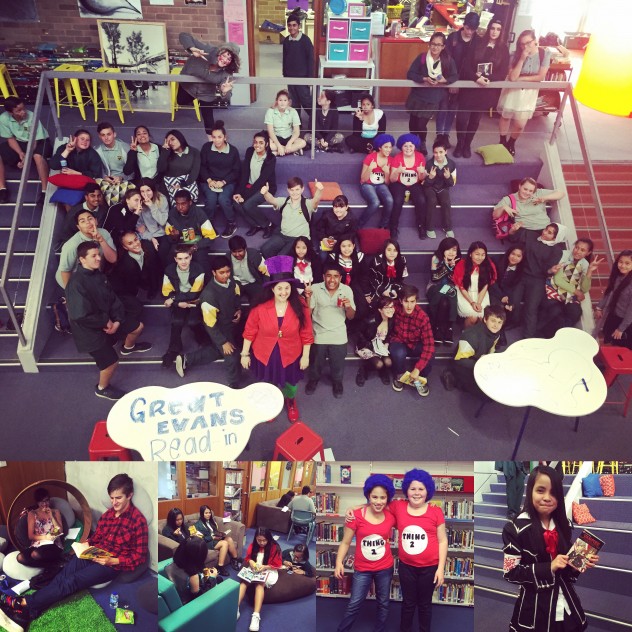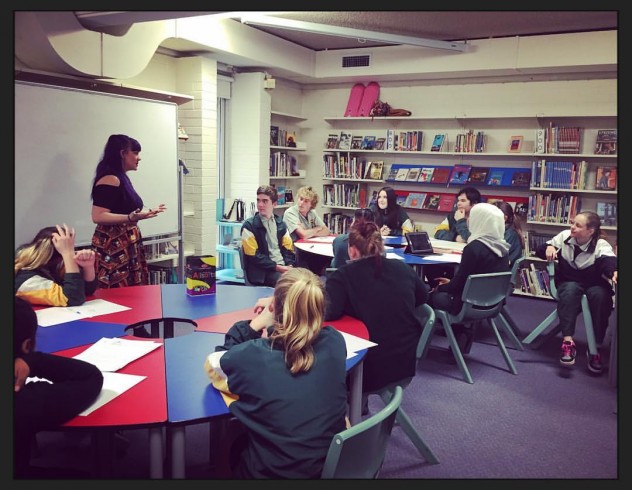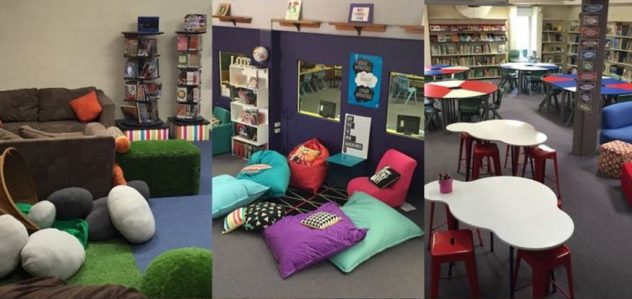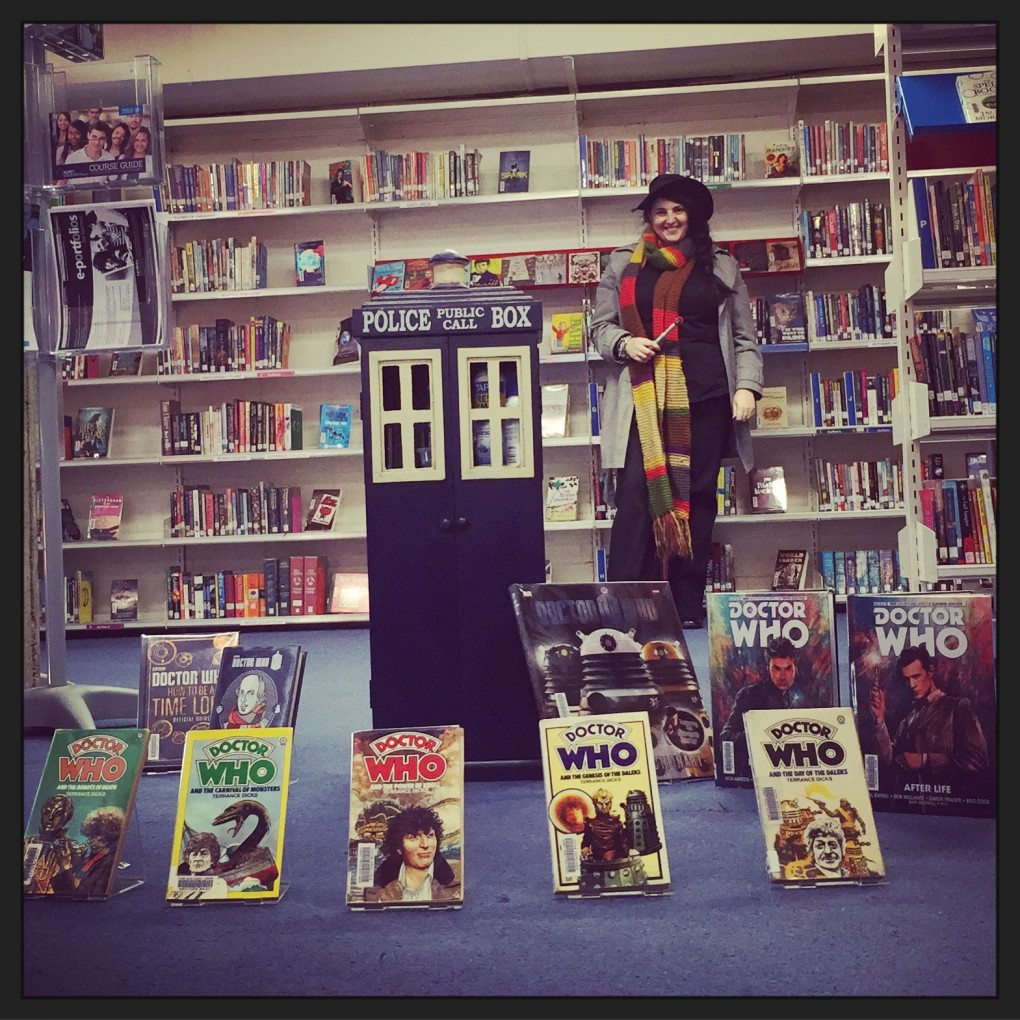Final thoughts?
ETL507 Reflective Portfolio Part 4 – Conclusion and References
Somehow, despite the time that putting this portfolio has taken, and the breadth of learning experiences it covers, this feels like a somewhat superficial exploration of the impact that the Masters in Education (Teacher Librarianship) has had on my life, and how I view myself as a teacher librarian. There are so many other elements that could easily have taken up an entire post on their own – decisions about reclassifying collection material, for example, establishing a quick reads collection organised by genre rather than DDC in order to support our beginning readers from the IEC. The Library Warriors crew, and its impact on engagement within the library. The development of our social media strategy, which has been used as a model for social media interactions for libraries both in NSW and interstate, through my presentations at numerous conferences. Our increasingly awesome book week celebrations, from their origins with a single hour long read-in three years ago to the week long Festival of Stories in 2016.
I made mention previously of a few of the changes that have been noted by staff members, and which I’m counting as my “measures of success”, as we strive to ensure that the Library@Evans meets the needs of our whole school community: here are a couple more, which really resonate with me, as indicators that what I do makes a difference. These awesome successes, the ones that impact the students’ connection with the library and confidence in their own learning, are the ones of which I am most proud, and will strive to continue to develop.
“ My Intensive English Foundation classes were introduced to the library- the novels in their language, anime, easy reader books were pointed out to them. I’m sure this simple introduction has led to the increased number of IEC students borrowing books and becoming a Library Warriors that I have noticed over the past 3 years. Also, while on playground duty in the library, there has been a huge increase in the number of IEC students working/ meeting/ utilising the library’s facilities at lunchtime.” OT, IEC Teacher
My Intensive English Foundation classes were introduced to the library- the novels in their language, anime, easy reader books were pointed out to them. I’m sure this simple introduction has led to the increased number of IEC students borrowing books and becoming a Library Warriors that I have noticed over the past 3 years. Also, while on playground duty in the library, there has been a huge increase in the number of IEC students working/ meeting/ utilising the library’s facilities at lunchtime.” OT, IEC Teacher
“I have been at Evans for 20 years plus and have been greatly heartened by changes made to the library over the past couple of years. It used to be the air conditioning that got kids into the library on hot or cold days, and patrons were thin on the ground a lot of the time when the weather was kinder. Now kids go to hang out and to meet books and enjoy the space and read books and talk about books. They use technology to work on their own stuff or assignments and make use of access to help and support.
The library is now owned by the students and if any new student wanders in, the actions of the library warriors and the happy buzz etc communicate quickly that this is a student friendly place. Evans kids are proud of their library because they like to be associated with excellence and innovation and ‘cool’.
 Apart from the great lessons taught to students by visiting authors etc, the fact that they are being paid deep respect by people with expertise who believe in their intelligence and creativity is in itself a terrific encouragement to students. Kids get inspired but they also get confidence to take risks -which is huge when it comes to their own writing.
Apart from the great lessons taught to students by visiting authors etc, the fact that they are being paid deep respect by people with expertise who believe in their intelligence and creativity is in itself a terrific encouragement to students. Kids get inspired but they also get confidence to take risks -which is huge when it comes to their own writing.
As I reflect on the many, varied roles I undertake on a daily basis, I’m reminded of Valenza’s comment about teacher librarians and what we do, in that “there is no textbook for what effective practice looks like in continually morphing information and communication landscapes” (2010). In many ways, we make it up as we go along – with reference to our community of TL’s, certainly, and to the research and literature that surrounds us. But largely, my experience as TL is going to be different from any other, because it is determined by the unique connections that surround me, and the needs and interests of my school community. And that’s both exciting and terrifying.
I’m incredibly grateful to the wonderful community that have supported me on this learning journey, and who enable me to be the best teacher librarian I can be. The colleagues who have encouraged me, and provided me with much needed feedback about our progress in the library. The CSU academics who have given me advice and support as I struggled with some of the complexities of this course. The fellow students as part of our super-secret “TL’s in Training” group, who have commiserated, collaborated, and basically been legends throughout this whole process. And finally, the people in my life who have my back. Family, friends, loved ones – you know who you are. Your support, your encouragement, and your presence in my life is what made this crazy “yes I can do post-grad study while working full time, being a single parent, and thinking I can do it all” gig possible. And you rock. Thank you, thank you, thank you.
References
Aguilar, E. (n.d.). Effective teams: The key to transforming schools? K-12 Education & Learning Innovations with Proven Strategies that Work | Edutopia. Retrieved May 29, 2014, from http://www.edutopia.org/blog/teacher-teams-transform-schools-elena-aguilar
ASLA/ ALIA (2016). Joint statement on school libraries and information and communication technologies. http://www.asla.org.au/policy/school-libraries-ICT.aspx
Bonanno, K (2011) A profession at the tipping point: time to change the game plan. http://vimeo.com/31003940
Fishburne, T. (n.d.) 8 types of leader. http://tomfishburne.com/2011/10/8-types-of-leader.html
Holland, B. (2014) 21st Century Libraries: The Learning Commons. https://www.edutopia.org/blog/21st-century-libraries-learning-commons-beth-holland
Hughes-Hassell, S. & Mancall, J. (2005). Collection management for youth : responding to the needs of learners. Chicago : American Library Association
Kuhlthau, C. (2010) Guided Inquiry: School Libraries in the 21st Century. School Libraries Worldwide January 2010, Volume 16, Number 1, 17-28. Accessed from http://comminfo.rutgers.edu/~kuhlthau/docs/GI-School-Librarians-in-the-21-Century.pdf
Lamb, A. (2011). Bursting with potential: Mixing a media specialist’s palette. Techtrends: Linking Research & Practice To Improve Learning, 55(4), 27-36.
Legeros, L. (2016) 5 ways to partner with students in a makerspace. Innovation: Education; The Tarrant Institute for Innovative Education: engaging learners through technology http://tiie.w3.uvm.edu/blog/partner-with-students-in-a-makerspace/#.WI3Ec1N973h
McGonigal, J. (2010) Gaming can make a better world. TED Talks. https://www.youtube.com/watch?v=dE1DuBesGYM
New Media Consortium. (2017) NMC Horizon Report: 2017 Library edition wiki: Makerspaces. http://library.wiki.nmc.org/Makerspaces
Olin, J. (2012). Letters to a young librarian: weeding is where it’s at: deacquisitioning in a small, academic library. Available at: http://letterstoayounglibrarian.blogspot.com.au/2012/01/weeding-is-where-its-at.html
Pennington, L (2010). Intergalactic Interdisciplinary Curriculum: Our place in the universe. New Horizons, Spring 2010. http://education.jhu.edu/PD/newhorizons/Journals/spring2010/intergalacticinterdisciplinarycurriculum/
Rodgers, T. (2014). ETL504 Teacher Librarian as Leader blog posts. https://www.tamarareads.com/category/etl504/
Rodgers, T. (2015a) Building Academic Library 2.0: Advice for Evans. https://www.tamarareads.com/2015/05/02/buildinglibrary20/
Rodgers, T. (2015b) Model collection policy reflections https://www.tamarareads.com/2016/07/22/model-collection-policy-reflections/
Rodgers, T, and Sarris, B. (2016) Oasis in the library. LearningHub: The journal of the School Library Association of NSW. Volume 2, Autumn 2016, p22.
Slatter, D, and Howard, Z. (2013) A place to make, hack, and learn: Makerspaces in Australian public libraries. The Australian Library Journal Vol. 62 , Iss. 4,2013. http://www.tandfonline.com/doi/full/10.1080/00049670.2013.853335?scroll=top&needAccess=true
UC Berkeley (2007) Building academic library 2.0. https://www.youtube.com/watch?v=q_uOKFhoznI
Valenza, J. (2010). A revised manifesto. http://blogs.slj.com/neverendingsearch/2010/12/03/a-revised-manifesto/
Waters, P. (2014) Makerspaces for students with special needs. Edutopia. https://www.edutopia.org/blog/makerspaces-students-with-special-needs-patrick-waters
Where to from here?
Back to the beginning – Introduction
Part 1 – The Role of the Teacher Librarian
Part 3 – Literacy and Literature
Part 4 – Conclusion and References (you are here)


I am in awe, reading your blog keeps me centred on my own studies and pushes me to be the best TL I can strive to be….but I will never be as awesome as you. #rodgersfanchook